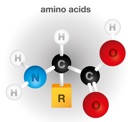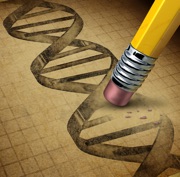 Understanding the cellular roles of DNA and protein is challenging because they are, in important and meaningful ways, not analogous to anything in the macroscopic world. Proteins are a fascinating study: while cars, watches and houses are built by specialized builders, a single master factory, the ribosome, strings together all cellular proteins. And in a richly meaningful sense, that string then assembles itself (folds) into its final form. And the machines of the cell are almost unimaginably diverse in their forms and functions, the latter of which derive once again from within: the amino acid building blocks and precisely where they come to rest in the final three dimensional structure.
Understanding the cellular roles of DNA and protein is challenging because they are, in important and meaningful ways, not analogous to anything in the macroscopic world. Proteins are a fascinating study: while cars, watches and houses are built by specialized builders, a single master factory, the ribosome, strings together all cellular proteins. And in a richly meaningful sense, that string then assembles itself (folds) into its final form. And the machines of the cell are almost unimaginably diverse in their forms and functions, the latter of which derive once again from within: the amino acid building blocks and precisely where they come to rest in the final three dimensional structure.
Structure/Function - 2. page
If I were Howard: improving upon the Phage Hunters project
 Undergraduate labs are notoriously dismal, certainly from the student point of view and often from faculty’s as well. One obvious reason is that the design and delivery must to some extent be cookie-cutter because materials and set-up must be planned for what may be dozens of sections, delivered to hundreds of students, and most often constrained to once-a-week, two- or three-hour meetings. The Howard Hughes Medical institute (HHMI) has sponsored the HHMI Phage Hunters (SEA-phage) project (and related UT Austin Freshman Research Initiative) with the goal of addressing several shortcomings of classical Intro Bio labs. I believe that it’s on the verge of being something truly awesome (at least from the point of view of a structure/function discovery-driven instructor) and greatness for ‘my’ target group could be by following the core thinking to different ends.
Undergraduate labs are notoriously dismal, certainly from the student point of view and often from faculty’s as well. One obvious reason is that the design and delivery must to some extent be cookie-cutter because materials and set-up must be planned for what may be dozens of sections, delivered to hundreds of students, and most often constrained to once-a-week, two- or three-hour meetings. The Howard Hughes Medical institute (HHMI) has sponsored the HHMI Phage Hunters (SEA-phage) project (and related UT Austin Freshman Research Initiative) with the goal of addressing several shortcomings of classical Intro Bio labs. I believe that it’s on the verge of being something truly awesome (at least from the point of view of a structure/function discovery-driven instructor) and greatness for ‘my’ target group could be by following the core thinking to different ends.
Proteins and their functions: execution, modification
Why combine protein function and modification? There’s a reason so many study sites have flashcard features, and it’s not just because they’re easy to program. I think textbooks and lecture can create the impression that introductory biology is nothing but a steady stream of equally-weighted, isolated terms and ‘things’. By finding and teaching relationships, we not only make big concepts easier to see and grasp, we increase the likelihood that they’ll stick and that students will feel a growing sense of power in their grasp of course material. This post will cover a unit that I think ties together a concrete example of enzyme function (ATPase), environmental effects and mechanism of pH (which is further explored in another thematic collection here), and protein control via phosphorylation (which, intriguingly, is achieved through a mechanism related to… ATPase chemistry!).
Protein trafficking: How did this get here?
 Cell biology can be a challenging aspect of Introductory Biology. It’s visually fascinating, the techniques are now incredibly diverse and powerful… but the usual issue arises: what are the concepts that we ought to be teaching? The topics include organelles, transport, membranes, compartmentalization… but why? I think that protein trafficking draws together many of these fundamental facts in the context of engaging students in questions and wonder. I also propose a framework for turning a potentially dry listing of facts and names-of-parts into a journey of exploration where students ‘accidentally’ learn techniques, organelle roles, and scientific community.
Cell biology can be a challenging aspect of Introductory Biology. It’s visually fascinating, the techniques are now incredibly diverse and powerful… but the usual issue arises: what are the concepts that we ought to be teaching? The topics include organelles, transport, membranes, compartmentalization… but why? I think that protein trafficking draws together many of these fundamental facts in the context of engaging students in questions and wonder. I also propose a framework for turning a potentially dry listing of facts and names-of-parts into a journey of exploration where students ‘accidentally’ learn techniques, organelle roles, and scientific community.
Biological timers GTPases in translation, microtubules, signals
The main point in teaching with themes is to give students a meaningful sense of familiarity so that their travels from topic to topic are visits with friends and known quantities rather than onslaughts of fresh vocabulary and new un-anchored idea-pieces. One triplet that I have enjoyed using in introductory biology is the set combining 1) EF-Tu and its role in promoting accuracy in translation, 2) the GTPase timer in tubular that gives rise to the grow-catastrophe-disassemble cycle in microtubules, and 3) the ‘self shut-off’ timer features of many G-protein coupled receptors. These are evolutionarily related machines and each applies the concept of ‘timing’ to a different biological circumstance. Thus, besides providing three examples of how biological machines solve problems, this theme ties in to previous ones on ATPase (GTPase mechanism is identical; the attached base has nothing to do with catalysis) and evolution through duplication and modification.
What’s important about… Concepts in Translation
Teaching biology at the cell/molecular level is challenging; as the Bob Seger song puts it ‘Deadlines and commitments/what to leave in… what to leave out.” How to decide? The glib answer is “identify the key concepts.” A definition of these might be “what are the aspects and ideas without which the process would not make sense, and which, if changed, would rock the cell’s world.” So… what are the Big Concepts of translation? Starting with negation, these cannot be the names or even the structures of the twenty amino acids (believed to be a combination of what was on hand in abundance ‘in the beginning’ and ‘discoveries’ that were biochemically accessible) nor their codon assignments, which, may reflect some physical correspondences, but seem to largely be a ‘frozen accident’ that we should not expect to find elsewhere. Rant: it cannot be the ability to ‘translate’ a message in a codons-to-amino-acids look-up table, as this has nothing whatever to do with the biological process! And the core cannot be a laundry list of actors and factors.
The big concepts in translation…
- « Previous
- 1
- 2
- 3
- Next »

